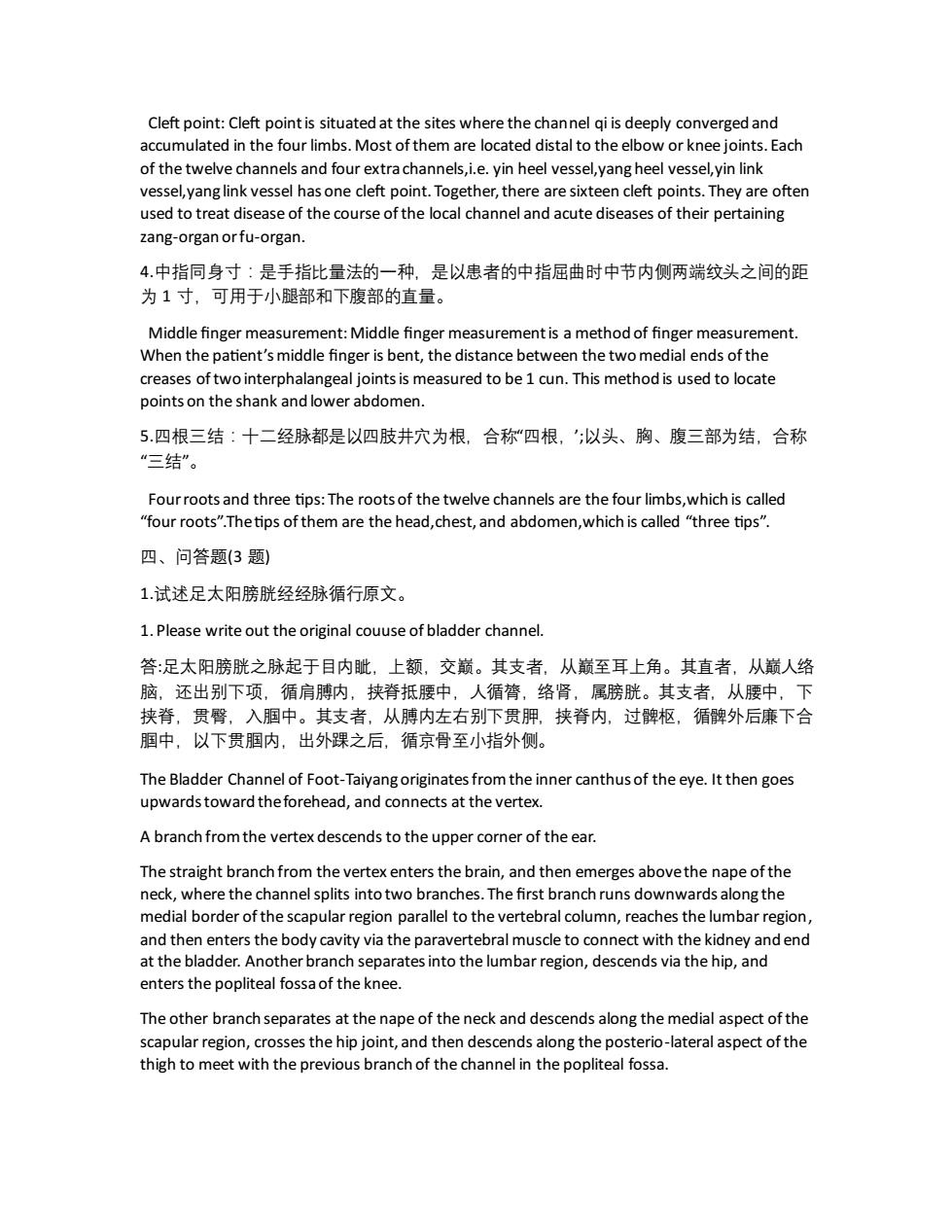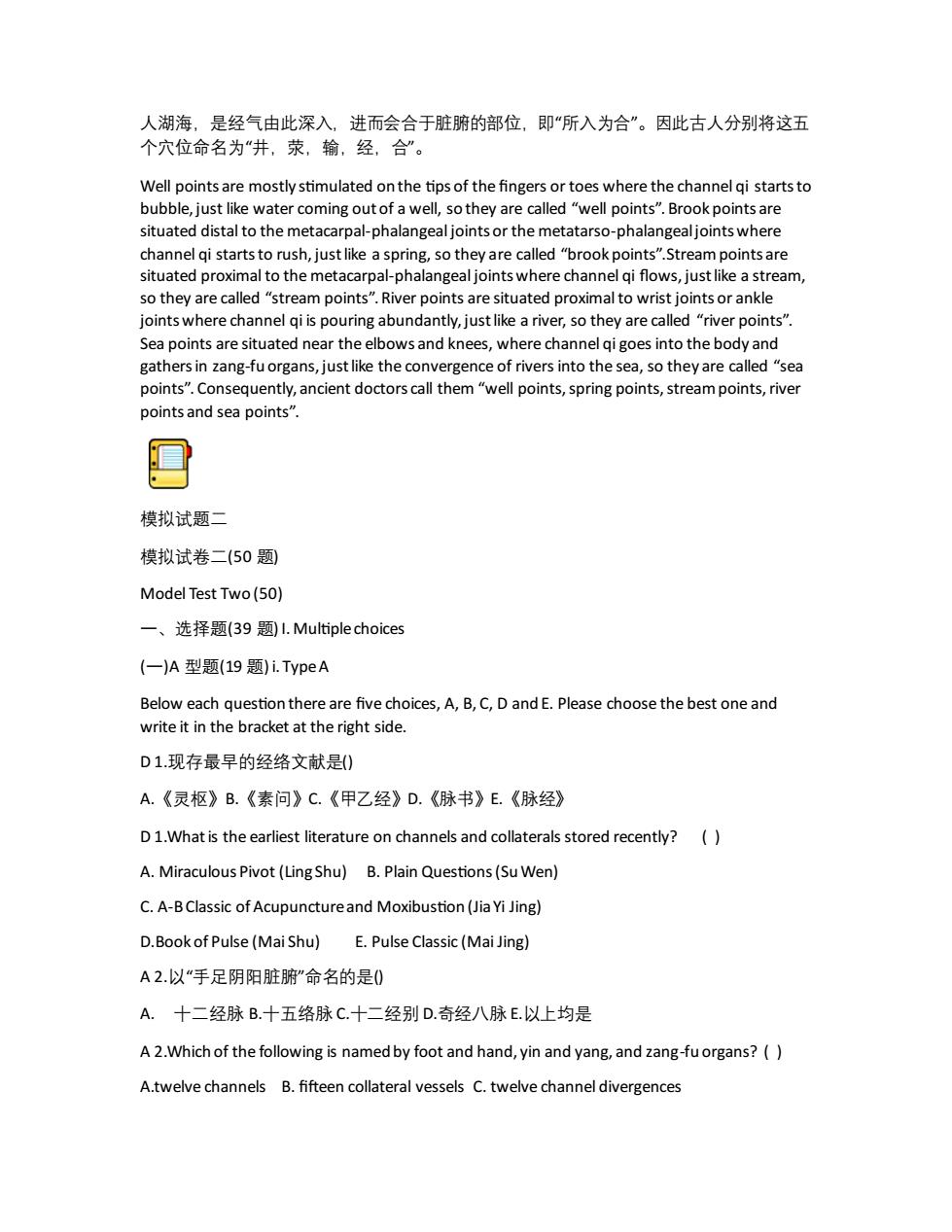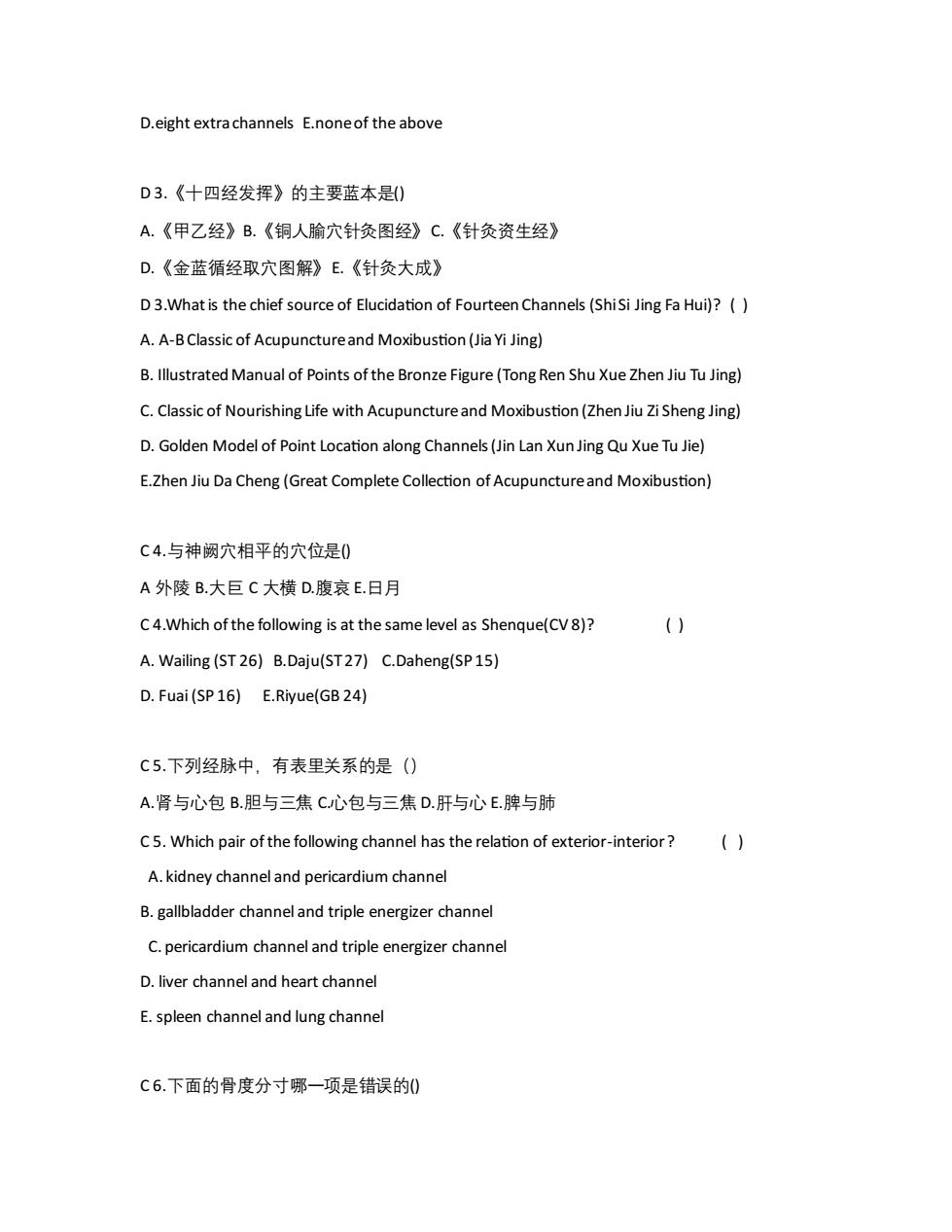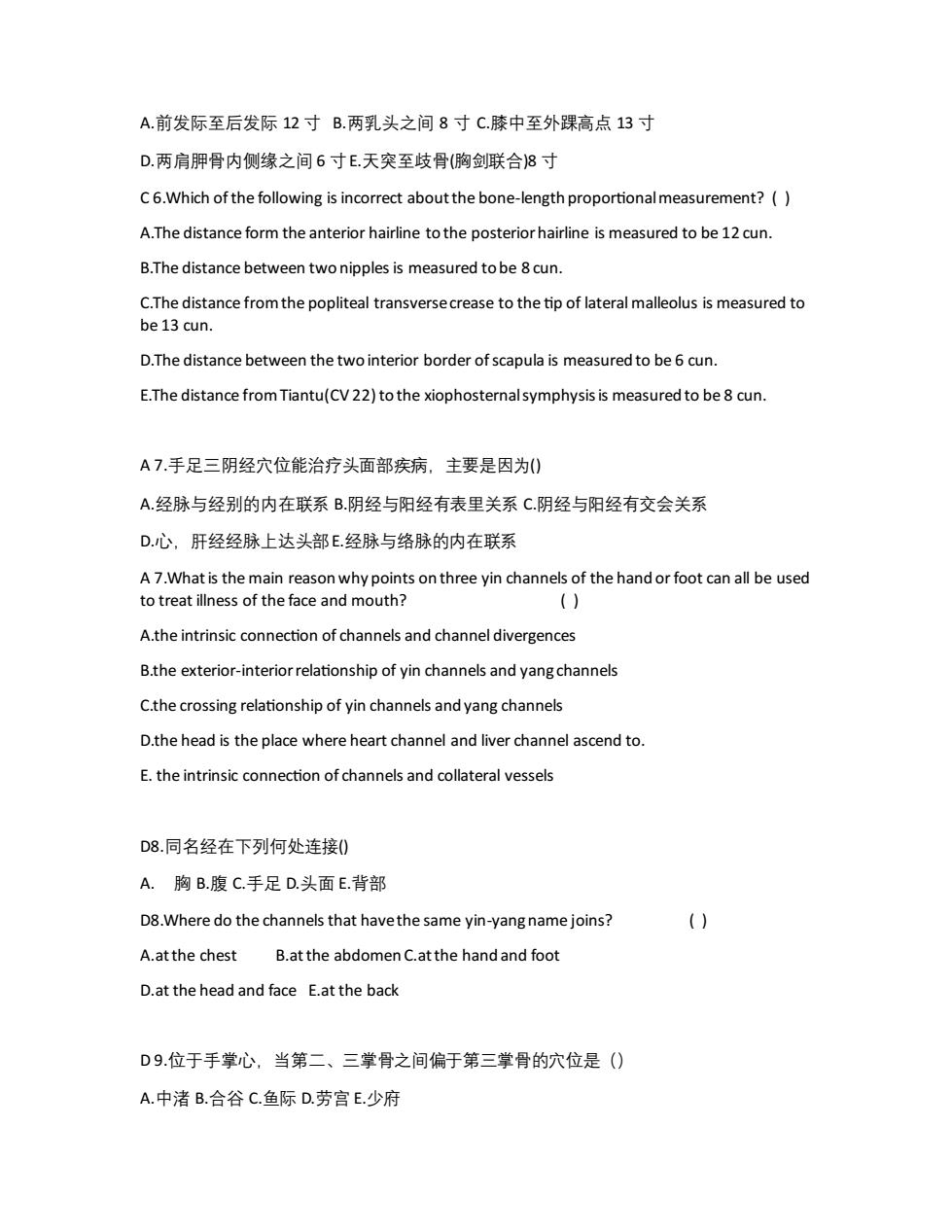
Cleft point:Cleft point is situated at the sites where the channel qi is deeply converged and accumulated in the four limbs.Most of them are located distal to the elbow or knee joints.Each of the twelve channels and four extra channels,i.e.yin heel vessel,yang heel vessel,yin link vessel,yang link vessel has one cleft point.Together,there are sixteen cleft points.They are often used to treat disease of the course of the local channel and acute diseases of their pertaining zang-organ orfu-organ. 4.中指同身寸:是手指比量法的一种,是以患者的中指屈曲时中节内侧两端纹头之间的距 为1寸,可用于小腿部和下腹部的直量。 Middle finger measurement:Middle finger measurement is a method of finger measurement. When the patient's middle finger is bent,the distance between the two medial ends of the creases of two interphalangeal joints is measured to be 1 cun.This method is used to locate points on the shank and lower abdomen. 5.四根三结:十二经脉都是以四肢井穴为根,合称“四根,;以头、胸、腹三部为结,合称 “三结”。 Four roots and three tips:The roots of the twelve channels are the four limbs,which is called "four roots".The tips of them are the head,chest,and abdomen,which is called "three tips". 四、问答题(3题) 1.试述足太阳膀胱经经脉循行原文。 1.Please write out the original couuse of bladder channel. 答:足太阳膀胱之脉起于目内眦,上额,交巅。其支者,从巅至耳上角。其直者,从巅人络 脑,还出别下项,循肩膊内,挟脊抵腰中,人循膂,络肾,属膀胱。其支者,从腰中,下 挟脊,贯臀,入腘中。其支者,从膊内左右别下贯胛,挟脊内,过髀枢,循髀外后廉下合 胭中,以下贯腘内,出外踝之后,循京骨至小指外侧。 The Bladder Channel of Foot-Taiyangoriginates from the inner canthus of the eye.It then goes upwards toward the forehead,and connects at the vertex. A branch from the vertex descends to the upper corner of the ear. The straight branch from the vertex enters the brain,and then emerges abovethe nape of the neck,where the channel splits into two branches.The first branch runs downwards along the medial border of the scapular region parallel to the vertebral column,reaches the lumbar region, and then enters the body cavity via the paravertebral muscle to connect with the kidney and end at the bladder.Another branch separates into the lumbar region,descends via the hip,and enters the popliteal fossa of the knee. The other branch separates at the nape of the neck and descends along the medial aspect of the scapular region,crosses the hip joint,and then descends along the posterio-lateral aspect of the thigh to meet with the previous branch of the channel in the popliteal fossa
Cleft point: Cleft point is situated at the sites where the channel qi is deeply converged and accumulated in the four limbs. Most of them are located distal to the elbow or knee joints. Each of the twelve channels and four extra channels,i.e. yin heel vessel,yang heel vessel,yin link vessel,yang link vessel has one cleft point. Together, there are sixteen cleft points. They are often used to treat disease of the course of the local channel and acute diseases of their pertaining zang-organ or fu-organ. 4.中指同身寸:是手指比量法的一种,是以患者的中指屈曲时中节内侧两端纹头之间的距 为 1 寸,可用于小腿部和下腹部的直量。 Middle finger measurement: Middle finger measurement is a method of finger measurement. When the patient’s middle finger is bent, the distance between the two medial ends of the creases of two interphalangeal joints is measured to be 1 cun. This method is used to locate points on the shank and lower abdomen. 5.四根三结:十二经脉都是以四肢井穴为根,合称“四根,’;以头、胸、腹三部为结,合称 “三结”。 Four roots and three tips: The roots of the twelve channels are the four limbs,which is called “four roots”.The tips of them are the head,chest, and abdomen,which is called “three tips”. 四、问答题(3 题) 1.试述足太阳膀胱经经脉循行原文。 1. Please write out the original couuse of bladder channel. 答:足太阳膀胱之脉起于目内眦,上额,交巅。其支者,从巅至耳上角。其直者,从巅人络 脑,还出别下项,循肩膊内,挟脊抵腰中,人循膂,络肾,属膀胱。其支者,从腰中,下 挟脊,贯臀,入腘中。其支者,从膊内左右别下贯胛,挟脊内,过髀枢,循髀外后廉下合 腘中,以下贯腘内,出外踝之后,循京骨至小指外侧。 The Bladder Channel of Foot-Taiyang originates from the inner canthus of the eye. It then goes upwards toward the forehead, and connects at the vertex. A branch from the vertex descends to the upper corner of the ear. The straight branch from the vertex enters the brain, and then emerges above the nape of the neck, where the channel splits into two branches. The first branch runs downwards along the medial border of the scapular region parallel to the vertebral column, reaches the lumbar region, and then enters the body cavity via the paravertebral muscle to connect with the kidney and end at the bladder. Another branch separates into the lumbar region, descends via the hip, and enters the popliteal fossa of the knee. The other branch separates at the nape of the neck and descends along the medial aspect of the scapular region, crosses the hip joint, and then descends along the posterio-lateral aspect of the thigh to meet with the previous branch of the channel in the popliteal fossa

From there,it descends through the gastrocnemius muscle,emerges posterior to the lateral malleolus,and follows along the fifth metatarsal boneto the lateral side of the tip of the little toe,where it communicates with the kidney channel. 2.为什么说督脉为“阳脉之海"? 2.Why is governor vessel called "sea of yang channels"? 答:督脉主干行于背部正中,入属于脑。“脑为元神之府”,“头为诸阳之会”背部属阳;另一方 面各阳经均交会于督脉如:手足三阳经交会于大椎;阳维脉交会于风府、哑门;带脉出于第二 腰椎。因此,称督脉为“阳脉之海”。正如滑伯仁《发挥》所言:“督之为言都也,行背部之 中,为阳脉之都纲”。 On one hand,governor vessel travels in the middle of the back,and enters the brain."The brain is the house of original spirit"."The head is the place where all yang channels converge".The back region belongs to yang.On the other hand,governor vessel is the place where all yang channels converge.For example,Dazhui(GV 14)is the place where three yang channels of foot or hand converge.Fengfu(GV 16)and Yamen(GV 15)are two crossing points of governor vessel and yang link vessel.Belt vessel goes out from the 2nd lumbar vertebra.Therefore,governor vessel is called "sea of yang channels".As is said by Hua Shou in Shi Si Jing Fa Hui (Elucidation of Fourteen Channels)"Governor vessel travels on the back and governs yang channels". 3.何为五输穴?其名称有何含义? 3.What is the definition of five transport points?What are the con notation meanings of them? 答:十二经脉在肘膝关节以下各有称为井、荥、输、经、合的五个腧穴,合称“五输穴”。 是按经气的由小到大,由浅而深所作的排列。故称“所出为井、所溜为荥、所注为输、所 行为经、所入为合”。 Five transport points refer to five groups of points distributed distally to the elbow or knee joints,namely well points,brook points,stream points,river points and sea points.They are arranged according to the amount of channel qi,from the little to the much and from the shallow to the deep. 古人把经气运行过程用自然界的水流由小到大、由浅入深的变化来形容,把五输穴按井、 荥、输、经、合的顺序,从四肢末端向肘、膝方向依次排列。 The ancient doctors described qi and blood flowing in the channels as water flowing from the spring into the sea,or going from the shallow to the deep in the natural world. “井”穴多位于手足之端,喻作水的源头,是经气所出的部位,即“所出为井”。“荥”穴多位 于掌指或跖趾关节之前,喻作水流尚微,萦迂未成大流,是经气流行的部位,即“所溜为 荥”。“输”穴多位于掌指或跖趾关节之后,喻作水流由小而大,由浅注深,是经气渐盛,由 此注彼的部位,即“所注为输”。“经”穴多位于腕踝关节以上,喻作水流变大,畅通无阻, 是经气正盛运行经过的部位,即“所行为经”。“合”穴位于肘膝关节附近,喻作江河水流汇
From there, it descends through the gastrocnemius muscle, emerges posterior to the lateral malleolus, and follows along the fifth metatarsal bone to the lateral side of the tip of the little toe, where it communicates with the kidney channel. 2.为什么说督脉为“阳脉之海”? 2. Why is governor vessel called “sea of yang channels”? 答:督脉主干行于背部正中,入属于脑。“脑为元神之府”,“头为诸阳之会”背部属阳;另一方 面各阳经均交会于督脉,如:手足三阳经交会于大椎;阳维脉交会于风府、哑门;带脉出于第二 腰椎。因此,称督脉为“阳脉之海”。正如滑伯仁《发挥》所言:“督之为言都也,行背部之 中,为阳脉之都纲”。 On one hand, governor vessel travels in the middle of the back, and enters the brain. “The brain is the house of original spirit”. “The head is the place where all yang channels converge”. The back region belongs to yang. On the other hand, governor vessel is the place where all yang channels converge. For example, Dazhui (GV 14) is the place where three yang channels of foot or hand converge. Fengfu(GV 16) and Yamen(GV 15) are two crossing points of governor vessel and yang link vessel. Belt vessel goes out from the 2nd lumbar vertebra. Therefore, governor vessel is called “sea of yang channels”. As is said by Hua Shou in Shi Si Jing Fa Hui (Elucidation of Fourteen Channels) “Governor vessel travels on the back and governs yang channels”. 3.何为五输穴?其名称有何含义? 3. What is the definition of five transport points? What are the connotation meanings of them? 答:十二经脉在肘膝关节以下各有称为井、荥、输、经、合的五个腧穴,合称“五输穴”。 是按经气的由小到大,由浅而深所作的排列。故称“所出为井、所溜为荥、所注为输、所 行为经、所入为合”。 Five transport points refer to five groups of points distributed distally to the elbow or knee joints, namely well points, brook points, stream points, river points and sea points. They are arranged according to the amount of channel qi, from the little to the much and from the shallow to the deep. 古人把经气运行过程用自然界的水流由小到大、由浅入深的变化来形容,把五输穴按井、 荥、输、经、合的顺序,从四肢末端向肘、膝方向依次排列。 The ancient doctors described qi and blood flowing in the channels as water flowing from the spring into the sea, or going from the shallow to the deep in the natural world. “井”穴多位于手足之端,喻作水的源头,是经气所出的部位,即“所出为井”。“荥”穴多位 于掌指或跖趾关节之前,喻作水流尚微,萦迂未成大流,是经气流行的部位,即“所溜为 荥”。“输”穴多位于掌指或跖趾关节之后,喻作水流由小而大,由浅注深,是经气渐盛,由 此注彼的部位,即“所注为输”。“经”穴多位于腕踝关节以上,喻作水流变大,畅通无阻, 是经气正盛运行经过的部位,即“所行为经”。“合”穴位于肘膝关节附近,喻作江河水流汇

人湖海,是经气由此深入,进而会合于脏腑的部位,即“所入为合”。因此古人分别将这五 个穴位命名为“井,荥,输,经,合”。 Well points are mostly stimulated on the tips of the fingers or toes where the channel qi starts to bubble,just like water coming out of a well,so they are called "well points".Brook points are situated distal to the metacarpal-phalangeal joints or the metatarso-phalangealjoints where channel qi starts to rush,just like a spring,so they are called "brook points".Stream points are situated proximal to the metacarpal-phalangeal joints where channel qi flows,just like a stream, so they are called "stream points".River points are situated proximal to wrist joints or ankle joints where channel qi is pouring abundantly,just like a river,so they are called "river points". Sea points are situated near the elbows and knees,where channel qi goes into the body and gathers in zang-fu organs,just like the convergence of rivers into the sea,so they are called "sea points".Consequently,ancient doctors call them "well points,spring points,stream points,river points and sea points". 模拟试题二 模拟试卷二(50题) Model Test Two(50) 一、选择题(39题)l.Multiple choices (一)A型题(19题)i.Type A Below each question there are five choices,A,B,C,D and E.Please choose the best one and write it in the bracket at the right side. D1.现存最早的经络文献是() A.《灵枢》B.《素问》C.《甲乙经》D.《脉书》E.《脉经》 D 1.What is the earliest literature on channels and collaterals stored recently?( A.Miraculous Pivot(Ling Shu)B.Plain Questions(Su Wen) C.A-B Classic of Acupuncture and Moxibustion (Jia Yi Jing) D.Book of Pulse(Mai Shu) E.Pulse Classic(Mai Jing) A2.以“手足阴阳脏腑”命名的是0 A.十二经脉B.十五络脉C.十二经别D.奇经八脉E.以上均是 A 2.Which of the following is named by foot and hand,yin and yang,and zang-fu organs?() A.twelve channels B.fifteen collateral vessels C.twelve channel divergences
人湖海,是经气由此深入,进而会合于脏腑的部位,即“所入为合”。因此古人分别将这五 个穴位命名为“井,荥,输,经,合”。 Well points are mostly stimulated on the tips of the fingers or toes where the channel qi starts to bubble, just like water coming out of a well, so they are called “well points”. Brook points are situated distal to the metacarpal-phalangeal joints or the metatarso-phalangeal joints where channel qi starts to rush, just like a spring, so they are called “brook points”.Stream points are situated proximal to the metacarpal-phalangeal joints where channel qi flows, just like a stream, so they are called “stream points”. River points are situated proximal to wrist joints or ankle joints where channel qi is pouring abundantly, just like a river, so they are called “river points”. Sea points are situated near the elbows and knees, where channel qi goes into the body and gathers in zang-fu organs, just like the convergence of rivers into the sea, so they are called “sea points”. Consequently, ancient doctors call them “well points, spring points, stream points, river points and sea points”. 模拟试题二 模拟试卷二(50 题) Model Test Two (50) 一、选择题(39 题) I. Multiple choices (一)A 型题(19 题) i. Type A Below each question there are five choices, A, B, C, D and E. Please choose the best one and write it in the bracket at the right side. D 1.现存最早的经络文献是() A.《灵枢》B.《素问》C.《甲乙经》D.《脉书》E.《脉经》 D 1.What is the earliest literature on channels and collaterals stored recently? ( ) A. Miraculous Pivot (Ling Shu) B. Plain Questions (Su Wen) C. A-B Classic of Acupuncture and Moxibustion (Jia Yi Jing) D.Book of Pulse (Mai Shu) E. Pulse Classic (Mai Jing) A 2.以“手足阴阳脏腑”命名的是() A. 十二经脉 B.十五络脉 C.十二经别 D.奇经八脉 E.以上均是 A 2.Which of the following is named by foot and hand, yin and yang, and zang-fu organs? ( ) A.twelve channels B. fifteen collateral vessels C. twelve channel divergences

D.eight extra channels E.none of the above D3.《十四经发挥》的主要蓝本是) A.《甲乙经》B.《铜人腧穴针灸图经》C.《针灸资生经》 D.《金蓝循经取穴图解》E.《针灸大成》 D3.What is the chief source of Elucidation of Fourteen Channels(ShiSi Jing Fa Hui)?() A.A-B Classic of Acupuncture and Moxibustion (Jia Yi Jing) B.Illustrated Manual of Points of the Bronze Figure(Tong Ren Shu Xue Zhen Jiu Tu Jing) C.Classic of Nourishing Life with Acupuncture and Moxibustion(Zhen Jiu Zi Sheng Jing) D.Golden Model of Point Location along Channels(Jin Lan Xun Jing Qu Xue Tu Jie) E.Zhen Jiu Da Cheng(Great Complete Collection of Acupuncture and Moxibustion) C4.与神阙穴相平的穴位是0 A外陵B.大巨C大横D.腹哀E.日月 C4.Which of the following is at the same level as Shenque(CV8)? () A.Wailing(ST 26)B.Daju(ST27)C.Daheng(SP15) D.Fuai(SP 16)E.Riyue(GB 24) C5.下列经脉中,有表里关系的是() A.肾与心包B.胆与三焦C心包与三焦D.肝与心E.脾与肺 C5.Which pair of the following channel has the relation of exterior-interior? () A.kidney channel and pericardium channel B.gallbladder channel and triple energizer channel C.pericardium channel and triple energizer channel D.liver channel and heart channel E.spleen channel and lung channel C6.下面的骨度分寸哪一项是错误的0
D.eight extra channels E.none of the above D 3.《十四经发挥》的主要蓝本是() A.《甲乙经》B.《铜人腧穴针灸图经》C.《针灸资生经》 D.《金蓝循经取穴图解》E.《针灸大成》 D 3.What is the chief source of Elucidation of Fourteen Channels (Shi Si Jing Fa Hui)? ( ) A. A-B Classic of Acupuncture and Moxibustion (Jia Yi Jing) B. Illustrated Manual of Points of the Bronze Figure (Tong Ren Shu Xue Zhen Jiu Tu Jing) C. Classic of Nourishing Life with Acupuncture and Moxibustion (Zhen Jiu Zi Sheng Jing) D. Golden Model of Point Location along Channels (Jin Lan Xun Jing Qu Xue Tu Jie) E.Zhen Jiu Da Cheng (Great Complete Collection of Acupuncture and Moxibustion) C 4.与神阙穴相平的穴位是() A 外陵 B.大巨 C 大横 D.腹哀 E.日月 C 4.Which of the following is at the same level as Shenque(CV 8)? ( ) A. Wailing (ST 26) B.Daju(ST 27) C.Daheng(SP 15) D. Fuai (SP 16) E.Riyue(GB 24) C 5.下列经脉中,有表里关系的是() A.肾与心包 B.胆与三焦 C.心包与三焦 D.肝与心 E.脾与肺 C 5. Which pair of the following channel has the relation of exterior-interior ? ( ) A. kidney channel and pericardium channel B. gallbladder channel and triple energizer channel C. pericardium channel and triple energizer channel D. liver channel and heart channel E. spleen channel and lung channel C 6.下面的骨度分寸哪一项是错误的()

A.前发际至后发际12寸B.两乳头之间8寸C.膝中至外踝高点13寸 D.两肩胛骨内侧缘之间6寸E.天突至歧骨(胸剑联合8寸 C 6.Which of the following is incorrect about the bone-length proportional measurement?() A.The distance form the anterior hairline to the posterior hairline is measured to be 12 cun. B.The distance between two nipples is measured to be 8 cun. C.The distance from the popliteal transverse crease to the tip of lateral malleolus is measured to be 13 cun. D.The distance between the two interior border of scapula is measured to be 6 cun. E.The distance from Tiantu(CV 22)to the xiophosternal symphysis is measured to be 8 cun. A7.手足三阴经穴位能治疗头面部疾病,主要是因为() A.经脉与经别的内在联系B.阴经与阳经有表里关系C.阴经与阳经有交会关系 D心,肝经经脉上达头部E经脉与络脉的内在联系 A 7.What is the main reason why points on three yin channels of the hand or foot can all be used to treat illness of the face and mouth? () A.the intrinsic connection of channels and channel divergences B.the exterior-interior relationship of yin channels and yang channels C.the crossing relationship of yin channels and yang channels D.the head is the place where heart channel and liver channel ascend to. E.the intrinsic connection of channels and collateral vessels D8.同名经在下列何处连接0 A.胸B.腹C.手足D.头面E.背部 D8.Where do the channels that have the same yin-yang name joins? () A.at the chest B.at the abdomen C.at the hand and foot D.at the head and face E.at the back D9.位于手掌心,当第二、三掌骨之间偏于第三掌骨的穴位是() A.中渚B.合谷C.鱼际D.劳宫E.少府
A.前发际至后发际 12 寸 B.两乳头之间 8 寸 C.膝中至外踝高点 13 寸 D.两肩胛骨内侧缘之间 6 寸E.天突至歧骨(胸剑联合)8 寸 C 6.Which of the following is incorrect about the bone-length proportional measurement? ( ) A.The distance form the anterior hairline to the posterior hairline is measured to be 12 cun. B.The distance between two nipples is measured to be 8 cun. C.The distance from the popliteal transverse crease to the tip of lateral malleolus is measured to be 13 cun. D.The distance between the two interior border of scapula is measured to be 6 cun. E.The distance from Tiantu(CV 22) to the xiophosternal symphysis is measured to be 8 cun. A 7.手足三阴经穴位能治疗头面部疾病,主要是因为() A.经脉与经别的内在联系 B.阴经与阳经有表里关系 C.阴经与阳经有交会关系 D.心,肝经经脉上达头部E.经脉与络脉的内在联系 A 7.What is the main reason why points on three yin channels of the hand or foot can all be used to treat illness of the face and mouth? ( ) A.the intrinsic connection of channels and channel divergences B.the exterior-interior relationship of yin channels and yang channels C.the crossing relationship of yin channels and yang channels D.the head is the place where heart channel and liver channel ascend to. E. the intrinsic connection of channels and collateral vessels D8.同名经在下列何处连接() A. 胸 B.腹 C.手足 D.头面 E.背部 D8.Where do the channels that have the same yin-yang name joins? ( ) A.at the chest B.at the abdomen C.at the hand and foot D.at the head and face E.at the back D 9.位于手掌心,当第二、三掌骨之间偏于第三掌骨的穴位是() A.中渚 B.合谷 C.鱼际 D.劳宫 E.少府